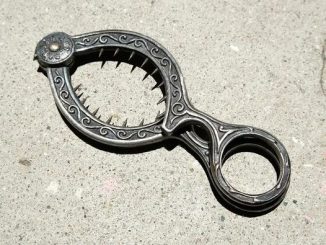
We have all had to deal with leaky pens and what they do to leather—put a broken ballpoint pen or Sharpie in a pants pocket or leather bag by mistake, and suddenly, a blue or black blotch appears on your leather jacket or couch. These pen marks last forever if untreated, and if you don’t know how to remove pen ink from leather, cleaning these stains can be frustrating and may result in a bigger mess.
You don’t want to cover up or throw away an expensive and good-looking piece of furniture or purse because of an ink stain, but what cleaning options do you have?
Fortunately, there are some tried-and-true methods for getting ink out of leather – some methods require specialized ink removers, and some of them need nothing more than household cleaning products. In this article, we’ve gathered some of the most effective ways to remove pen ink from leather
How to Get Ink Out of Leather
Evaluate your stain and determine the best way to treat it. How to remove an old oil stain from a leather bag is a little different than dealing with ink.
Use Hair Spray on the Stain
The magic ingredient in hair spray that works on ink stains is isopropyl alcohol, otherwise known as plain old rubbing alcohol. Over time, companies have reduced or phased out isopropyl alcohol levels in hair spray completely, so this method is not as effective as it once was.
However, if you don’t have rubbing alcohol in the home, you can use a hair spray with a relatively high alcohol content to clean your leather. Before you try to clean pen marks with hair spray, you should test the cleaning method on an inconspicuous place on the leather.
Spray the pen marks, allow it to sit for several minutes, and then rinse the spot with cool water. Afterward, dab – don’t rub – the place with a dry cloth or paper towel.
Apply Alcohol to the Stain
Alcohol can be useful for how to remove Sharpie or other ink from leather but it can damage leather if you apply it carelessly. Isopropyl (rubbing) alcohol is the most effective. Denatured alcohol or nail polish remover may work better, but you run a higher risk of damaging the leather.
Make sure to test the alcohol in a hidden spot before using it on the stain to ensure that you will not harm the fabric. Apply the alcohol with a cotton swab or cotton ball and rub lightly as you apply.
The ink should soak into the cotton swab. Do not allow the alcohol to sit too long after application – quickly dry the area with a hairdryer, if possible, or it might eat away at the leather.
For Non-White Leather, Try this Homemade Leather Cleaner
This home remedy is effective and safe to use on non-white leather, but always make sure to test the mix on a small area first.
Lemon Juice-Based DIY Leather Cleaner Recipe
1 part lemon juice
1 part cream of tartar
Mix the two ingredients into a paste. Then, apply the mixture to the ink spot using a microfiber cloth. Work the paste into the stain, and let it sit for a few hours if the stain remains.
Once you have cleaned the area with a damp cloth, apply a commercial or DIY leather conditioner to ensure that the leather is maintained, and you are working on a piece of leather furniture, be sure to always follow the tips for cleaning a leather couch for best results.
Homemade Cleaner for White Leather
White leather is more sensitive to caustic ingredients, so if you have an ink spot on white leather, use this cleaner. Make sure to test the cleaner in an inconspicuous area first.
DIY White Leather Cleaner Recipe
1/4 cup vinegar
1/2 cup olive oil
Mix the ingredients in a spray bottle. Spray the mixture on the affected area, and let it sit for five minutes or so before wiping it off.
As with non-white leather, you should apply a professional or DIY leather conditioner to properly maintain the leather, and if you are cleaning leather furniture, make sure to follow the tips for cleaning a leather couch.
Use a Commercial Leather Cleaning Product
If your home remedies don’t work for removing acrylic paint from leather, commercial cleaners might be the way to go. They can cost a bit, but they are guaranteed to not damage your leather if used correctly.
As with home cleaning solutions, however, you should always test the product on a small area before trying them on the stain.
Commercial Cleaning Product Advantages
They are carefully tested and should be safe for cleaning leather.
They may work better on stubborn stains.
They usually require no mixing or measuring.
Melamine foam, also known as a Magic Eraser, is a significant first step toward stain removal. If the Magic Eraser doesn’t do the trick, try to remove pen from leather with liquid cleaners.
There are many excellent commercial leather products available, and many of them are valid on ink stains. Choose the best one for your needs, and you should always follow the included cleaning instructions.
Take It to a Dry Cleaner
If all else has failed you and you’re willing to pay to get your leather
purse or sofa back to pristine condition, you might consider a trip to the dry cleaners. Dry cleaners have a lot more tools and tricks to get Sharpie off of leather, and they have access to more powerful cleaning chemicals.
If you choose to take your leather to a dry cleaner, you should always do research and choose a reputable business. And, be sure to inform the cleaning staff of any special care instructions before entrusting them with your leather.
After you’ve cleaned out the stain, consider applying a leather protector to avoid future stains. It doesn’t require ballpoint ink to damage leather, after all—a single drop of water on unprotected leather can ruin it.
If you’re the victim of a broken ink pen and have been unfortunate enough to find yourself with a big black or blue ink stain spreading across your favorite leather item, we hope that you found this article on how to get pen ink out of leather to be helpful.
Whether you use a home cleaning solution or a professional, patience and persistence can get your leather goods clean, ink-free, and beautiful again.
Thanks very much for reading our tips on how to remove pen ink from leather. Please share these ink stain removal tips with your friends on Facebook and
5 Ways to Tell if an Egg is Fresh or Rotten

When using eggs in recipes, have you ever felt dubious about their freshness? Because the white and yolk conditions of eggs are hidden by their shells, judging them can be challenging. Don’t worry, though; we’ll also provide some tips on how to cut down on egg-related food waste and provide you with some simple ways to tell if an egg is fresh.
The package of eggs you purchase from the grocery always includes a suggested use-by date. It may surprise you to learn that eggs cannot be sold in France seven days before to the minimum durability date specified on the packaging. When purchasing eggs straight from a henhouse, you should be aware that the use-by date is only a maximum of 28 days following the day of laying.
You can store eggs in the refrigerator for up to one month after the recommended use-by date, which is 58 days after they were laid, so don’t worry if the shells are not cracked or broken. Sufficient storage practices aid in preserving freshness, averting mold growth, and combating food waste. Do not forget to refrigerate your eggs to prevent any health hazards.

Eggs that have gone bad can smell weird, just like any other fresh product. Give an egg a whiff first if you wish to save it for later use and you see that its expiration date has passed. Eggs that have gone bad frequently smell bad and shouldn’t be consumed because they can have lost their vitamins and tasted different. Go ahead and promptly consume the egg by preparing an omelette, for example, if the fragrance seems natural to you.
You may also tell if an egg is still edible or has expired by using your eyes. Examine the shell thoroughly to minimize dangers. Mold may be present in the shell if it looks powdered, sticky, broken, or in any other dubious condition. Furthermore, in the event that the egg white or yolk exhibits any peculiar discoloration, such as blue, pink, black, or green, after being cracked into a bowl.



Leave a Reply